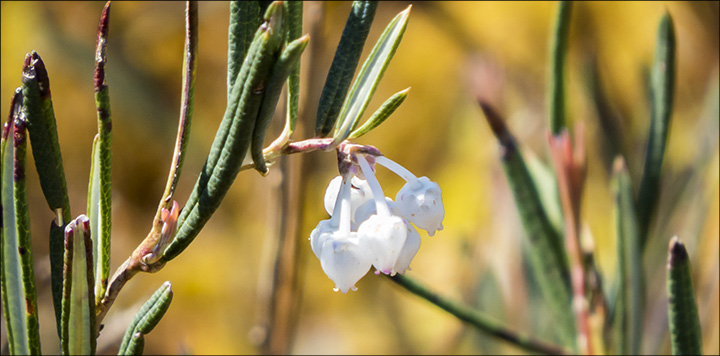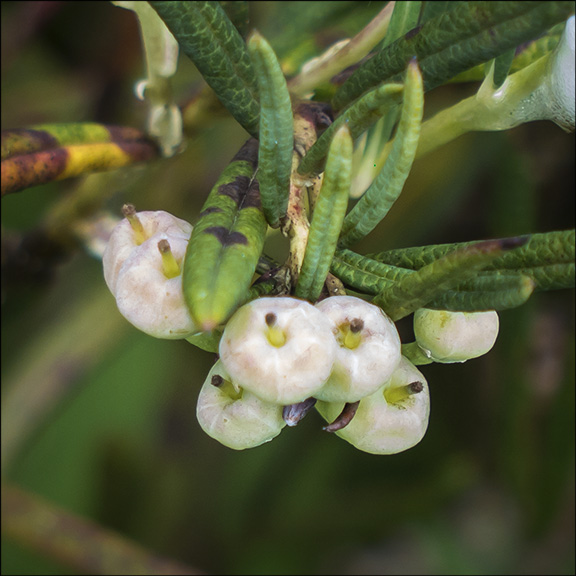Adirondack Shrubs:
Bog Rosemary (Andromeda polifolia)
 Adirondack Shrubs: Bog Rosemary (Andromeda polifolia) on the Boreal Life Trail (23 May 2015)
Adirondack Shrubs: Bog Rosemary (Andromeda polifolia) on the Boreal Life Trail (23 May 2015)
| This page is no longer being updated. For an updated and expanded version of this material, see: Bog Rosemary (Andromeda polifolia) |
Bog Rosemary (Andromeda polifolia) is a small, native evergreen shrub with blue-gray foliage which produces small pinkish flowers in spring. It grows in bogs at the Paul Smiths VIC and other locations in the Adirondack Mountains and upstate New York. Bog Rosemary is a member of the Heath family. The common name of this plant reflects the fact that its leaves are similar to those of common garden Rosemary, although the two plants are totally unrelated. The Bog Rosemary was given its Latin name by Linnaeus, who compared it with the goddess Andromeda: Andromeda was chained to a rock in the sea, while the Bog Rosemary is fixed to the middle of wetlands.
Identification of Bog Rosemary: Bog Rosemary is one of several leathery-leafed plants growing in swampy or boggy habitats. It grows up to two feet tall. The plant has small terminal clusters of bell-shaped nodding flowers, which appear in mid-spring. Each flower is about a quarter of an inch long. The flowers are usually pale pink, but can also be white. The dark green evergreen leaves are 2 inches long and about a quarter of an inch wide. The leaf margins are smooth. The leaves are alternate; that is, the leaves merge from the stem one at a time. The leaves roll inwards. The underside of the leaves is whitened by tiny hairs. The fruit is a dry, rounded capsule, appearing in July.

Keys to identifying Bog Rosemary and differentiating it from other leathery-leafed plants growing in swampy or boggy habitats include the leaf arrangement and the flowers.
- Sheep Laurel and Bog Laurel both have opposite leaves, in contrast to Bog Rosemary, which has alternate leaves
- Leatherleaf and Labrador Tea also have alternate leaves, like Bog Rosemary. However, the leaf margins of the Leatherleaf are not inrolled and the undersides of the leaves have yellow, waxy deposits. Labrador Tea has much wider leaves with long rusty to whitish undersides and hairy twigs.
- Bog Rosemary flowers are distinct from those of other evergreen shrubs which flourish in bogs. The flowers are bell-shaped, like those of Leatherleaf, but are arrayed on the plant in a completely different way. The white Leatherleaf bells appear on axils of the current year's leaves, forming a one-side raceme, while the pinkish Bog Rosemary flowers appear in clusters at the end of the branch. Bog Laurel flowers also appear to be on the end of the branch' however, the flowers are a much darker rose-purple and are not in the shape of a bell. Sheep Laurel flowers appear in lateral clusters grouped near the previous year's leaves; that is, the leaves appear farther down on the branch, with new leaf growth above.

Uses of Bog Rosemary: Although some Native American Indian tribes reportedly used the fresh or dried leaves of Bog Rosemary for a tea, all parts of the plant are said to be toxic in large quantities. No parts of it should be eaten. Symptoms of poisoning include watering of the mouth, eyes, and nose; loss of energy; slow pulse; vomiting; low blood pressure; lack of coordination; convulsion; and progressive paralysis.
Distribution of Bog Rosemary: Bog Rosemary grows in acidic soil in bogs and fens in the northeast US, as well as throughout Canada. The plant may be found in bogs at the Paul Smiths VIC and other locations in the Adirondack Mountains and upstate New York.
At the Paul Smiths VIC, you can find Bog Rosemary on Barnum Bog, accessible from the Boreal Life Trail boardwalk. Bog Rosemary usually blooms in this part of the Adirondack Park in May, depending on the weather. Look for Bog Rosemary growing alongside other bog-dwelling evergreen shrubs, including Labrador Tea, Bog Laurel, and Sheep Laurel. Wildflowers that flourish in this habitat include Cotton Grass, Pitcher Plant, Grass Pink, Rose Pogonia, Buckbean, and Marsh Cinquefoil. Birds found in this habitat include the Palm Warbler, Lincoln's Sparrow, and Yellow-bellied Flycatcher.
References
- Lady Bird Johnson Wildflower Center. Native Plant Database.
- United States Department of Agriculture. Plants Database.
- University of Michigan. Native American Ethnobotany. A Database of Foods, Drugs, Dyes and Fibers of Native American Peoples, Derived from Plants.
- NatureServe Explorer. Online Encyclopedia of Life.
- Plants for a Future. Database.
- University of Wisconsin. Flora of Wisconsin.
- University of Wisconsin. Shrubs of Wisconsin.
- Connecticut Wildflowers. Wildflower Guide.
- New York Flora Association. New York Flora Atlas.
- ENature. Wildflower Field Guide.
- Minnesota Wildflowers. Database.
- New England Wildflower Society. Andromeda polifolia. Retrieved 29 March 2015.
- Birds of the Boreal Life Trail. Barnum Bog Birds. VIC Birding Trail Guide (June, 2015)
- Doug Ladd. North Woods Wildflowers (Falcon Publishing, 2001), p. 73.
- Lawrence Newcomb. Newcomb's Wildflower Guide (Little Brown and Company, 1977), pp. 292-293.
- Meiyin Wu and Dennis Kalma. Wetland Plants of the Adirondacks. Ferns, Woody Plants, and Graminoids(Trafford Publishing, 2010), pp. 39, 61, 62.
- Charles W. Johnson. Bogs of the Northeast (Hanover, New Hampshire: University Press of New England, 1985), p. 29.
- Donald D. Cox. A Naturalist's Guide to Wetland Plants. An Ecology for Eastern North America (Syracuse University Press, 2002), pp. 83-84, 90.
- John Eastman. The Book of Swamp and Bog. Trees, Shrubs, and Wildflowers of Eastern Freshwater Wetlands (Mechanicsburg, PA: Stackpole Books, 1995), pp. 25-26.
- David M. Brandenburg. Field Guide to Wildflowers of North America (New York, NY: Sterling Publishing Company, Inc., 2010), p. 215.
- George A. Petrides. A Field Guide to Trees and Shrubs (Boston: Houghton Mifflin Company, 1958,1972), pp. 288, 364-365.
- Janet Lyons and Sandra Jordon. Walking the Wetlands. A Hiker's Guide to Common Plants and Animals of Marshes, Bogs, and Swamps (New York, NY: John Wiley & Sons, Inc., 1989), pp. 91-92.
